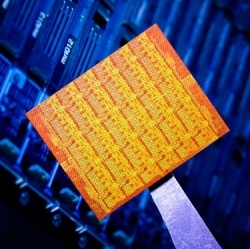
To create a computer as powerful as the human brain, perhaps we first need to build one that works more like a brain. Today, at the International Joint Conference on Neural Networks in Dallas, IBM researchers will unveil a radically new computer architecture designed to bring that goal within reach. Using simulations of enormous complexity, they show that the architecture, named TrueNorth, could lead to a new generation of machines that function more like biological brains.
The announcement builds on IBM’s ongoing projects in cognitive computing. In 2011, the research team released computer chips that use a network of “neurosynaptic cores” to manage information in a way that resembles the functioning of neurons in a brain (see “IBM’s New Chips Compute More Like We Do”). With TrueNorth, the researchers demonstrate a way to use those chips for specific tasks, and they show that the approach could be used to build, among other things, a more efficient biologically inspired visual sensor.
“It doesn’t make sense to take a programming language from the previous era and try to adapt it to a new architecture. It’s like a square peg in a round hole,” said Dharmendra S. Modha, lead researcher. “You have to rethink the very notion of what programming means.”
